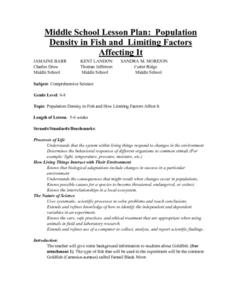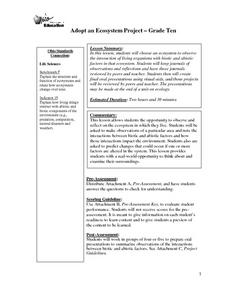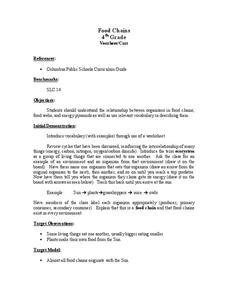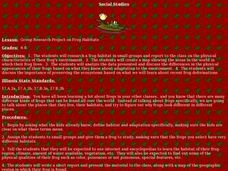Curated OER
How Appropriate is that Tree?
Students identify trees and their environments using a dichotomous chart. In this exploratory lesson plan students use the Internet to identify conditions needed for the trees and what the climate is in their area.
Curated OER
Creature Features
Learners examine why certain animals live in only specific places throughout the world. Using animals, they classify them based on their characteristics and identify their basic needs. They also observe and compare the life cycles of...
Curated OER
Who's Coming to Dinner?
Students identify the role predators/prey play in food chains, differentiate between food chains and webs, identify factors that affect the balance in food webs, and propose solutions to protect endangered species' environments and...
Curated OER
Biocomplexity Lab Activity: Measuring Water pH
Young scholars test unknown solutions for pH levels to determine which organism can live in each environment. They name three substances that they think are acids. Students determine a solution is an acid or base. They define the term pH.
Curated OER
Designer Genes For A Designer World
Students explore how organisms adapt to their environments through changes in their genetic codes. They create make-believe creatures and environments that have specific characteristics.
Curated OER
Environmental Education (Grade 4 - Lesson 2)
Fourth graders discuss ways in which the environment is helpful to humans. They discover how their actions affect the environment. They identify how animals and humans are subjected to the same environmental conditions.
Curated OER
Habitat survival
Sixth graders study different environments and how the food chain affects the survival of different animals. For this environments lesson plan, 6th graders share the visuals which describe the characteristics of the environment that they...
Curated OER
Where Do Your Veggies Grow?
First graders investigate the origins of vegetables. In this Science lesson, 1st graders identify where fruits and vegetables come from. Students describe how people utilize plants.
Curated OER
Ecosystems: What Are They and How Do They Work?
Learners explore the characteristics of major ecosystems, the interactions of the organisms within the systems, and the effects of humans on the system. Both living and non-living components are examined in this five instructional...
Curated OER
Population Density In Fish
Students investigate how a population of fish multiplies in an ecosystem and the kinds of things that must be done to maintain a healthy population balance with other organisms that live there. They conduct an experiment to test the...
Curated OER
Frogs and Camouflage
Students view a variety of pictures of frogs and discuss camouflage and habitat adaptation. Students look at color, skin texture, shape, size, eyes, and surroundings as well as the need for the camouflage. Students then design a frog...
Curated OER
Learning From Leaves: From Observation to Inference
Learners examine the adaptation of plants to their environments. They analyze and observe the structure, shape, and internal structure of various leaves, and make inferences about the structures.
Curated OER
A Day in a Life of an Arctic/Antarctic Animal
Students, through video segments, explore what types of animals live in the Arctic and Antarctica. They also clear up any misconceptions they have about penguins or polar bears.
Curated OER
Trees at Work... Just Look!
Pupils investigate the significance of trees. They collect magazine pictures of animals that live in trees, list products that are made from trees, collect twigs and create an item using the sticks, and bring in and discuss food from trees.
Curated OER
Adopt An Ecosystem
Tenth graders choose an ecosystem to observe the interaction of living organisms with biotic and abiotic factors in that ecosystem. They keep journals of observations and reflections in order to have a resource for further...
Curated OER
The Nitrogen Cycle
Students study the nitrogen cycle and construct a diagram. In this Earth Science lesson students use role play to see the various paths.
Curated OER
The Parts of an Insect
Students examine various insects. They discuss the parts of an insect and the environments in which they live. Students explore the importance of insects to our environment. They draw an interpretation of their insect and label its parts.
Curated OER
Survival Under a Rock
Students investigate ways that animals adapt to their environments through hands-on activities using isopods and an interactive video.
Curated OER
Water Pollution, Stream Ecosystems
Students participate in a series of simulated activities designed to demonstrate the interconnectedness between the environment and the organisms that live there. They explore how polluting one element of an environment affects the...
Curated OER
Food Chains
Fourth graders investigate food chains. They review cycles and discuss ecosystems. They select an environment and create a food chain in small groups. They write their food chain and label it for the class to evaluate. They create...
Curated OER
Fertilized Death Water
Students investigate the effect of chemicals on Platyhelminthes and planaria development. They observe the growth and development of planaria and investigate what fertilizer can do to living organisms when it is introduced into their...
Curated OER
Group Research Project on Frog Habitats
Learners identify and research a frog habitat in small groups and compile a report to present to the class on the physical characteristics of their frog's environment. Students create a map illustrating areas in the world where their...
Curated OER
Eco-Warrior
Students recognize that a man's actions in changing his environment can have drastic results for their world. They discuss the use of energy conservation and the use of recycling materials to improve our environment.
Curated OER
Save the Earth: It's Everyone's Home!
Students complete activities to become more aware of environmental issues and the effect on plants and animals. In this environmental issues lesson, students use a globe to discuss issues with the environment. Students then take a trip...























